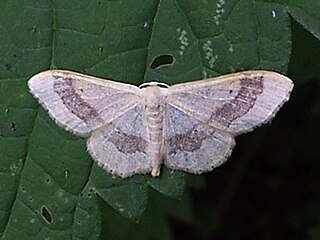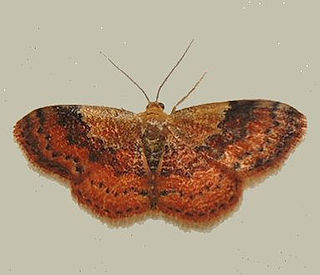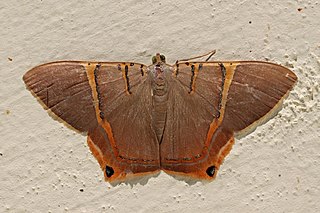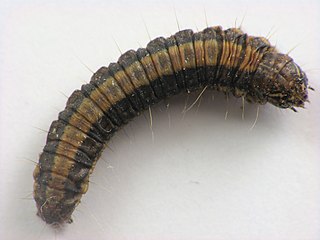| Antepirrhoe | |
|---|---|
 | |
| Scientific classification | |
| Kingdom: | |
| Phylum: | |
| Class: | |
| Order: | |
| Family: | |
| Subfamily: | |
| Tribe: | |
| Genus: | Antepirrhoe Warren, 1905 |
Antepirrhoe is a genus of moths in the family Geometridae described by Warren in 1905. [1]
| Antepirrhoe | |
|---|---|
 | |
| Scientific classification | |
| Kingdom: | |
| Phylum: | |
| Class: | |
| Order: | |
| Family: | |
| Subfamily: | |
| Tribe: | |
| Genus: | Antepirrhoe Warren, 1905 |
Antepirrhoe is a genus of moths in the family Geometridae described by Warren in 1905. [1]

Idaea, sometimes called Hyriogona, is a large genus of geometer moths. It was erected by Georg Friedrich Treitschke in 1825. They are found nearly worldwide, with many native to the Mediterranean, the African savannas, and the deserts of western Asia.

Crambinae is a large subfamily of the lepidopteran family Crambidae, the crambid snout moths. It currently includes over 1,800 species worldwide. The larvae are root feeders or stem borers, mostly on grasses. A few species are pests of sod grasses, maize, sugar cane, rice, and other Poaceae. The monophyly of this group is supported by the structure of the tympanal organs and the phallus attached medially to the juxta.

Though small in absolute diversity of genera, the Hemitheini are nonetheless the largest tribes of geometer moths in the subfamily Geometrinae. Like most Geometrinae, they are small greenish "emerald moths". The tribe was first described by Charles Théophile Bruand d'Uzelle in 1846.

Orthonama obstipata, the gem, is a moth of the family Geometridae. The species was first described by Johan Christian Fabricius in 1794. It is common in continental Europe and adjacent lands, though in the northeast, its range does not significantly extend beyond the Baltic region and it is absent from northern Russia. This well-flying species is somewhat prone to vagrancy and able to cross considerable distances of open sea; it can thus be regularly found on the British Isles and even on Iceland.

Anania is a genus of moths of the family Crambidae described by Jacob Hübner in 1823.

Loxostege is a genus of moths of the family Crambidae.

Leptostales is a genus of moths in the family Geometridae.
Lobocleta is a genus of moths in the family Geometridae erected by Warren in 1906.

Perizoma is a genus in the geometer moth family (Geometridae). It is the type genus of tribe Perizomini in subfamily Larentiinae. The tribe is considered monotypic by those who include the genera Gagitodes, Martania and Mesotype in Perizoma. Some other less closely related species formerly placed here are now elsewhere in the Larentiinae, e.g. in Entephria of the tribe Larentiini.

Pero is a genus of moths in the family Geometridae erected by Gottlieb August Wilhelm Herrich-Schäffer in 1855.

Phrygionis is a neotropical moth genus in the family Geometridae.

Scopula is a genus of moths in the family Geometridae described by Franz von Paula Schrank in 1802.

Semiothisa is a genus of moths in the family Geometridae. It was erected by Jacob Hübner in 1818.

Synchlora is a genus of moths in the family Geometridae erected by Achille Guenée in 1857.

The Epipaschiinae are a subfamily of snout moths. Almost 600 species are known today, which are found mainly in the tropics and subtropics. Some occur in temperate regions, but the subfamily is apparently completely absent from Europe, at least as native species. A few Epipaschiinae are crop pests that may occasionally become economically significant.
Homoeosoma is a genus of moths of the family Pyralidae.

Sterrhini is a tribe of the geometer moth family (Geometridae), with about 825 species in 19 genera. There are also 6 genera with 36 species tentatively associated with the tribe. The tribe was described by Meyrick in 1892.

The Siege of Hulst of 1596 was a Spanish victory led by Archduke Albert that took place between mid-July and August 18, 1596, at the city of Hulst, Province of Zeeland, Low Countries, during the Eighty Years' War, the Anglo-Spanish War (1585–1604). After a short siege, during which Maurice of Orange launched a failed attempt to relieve the city – the garrison of Dutch and English troops fell into Spanish hands on August 18, 1596.

The Siege of Hulst was a siege of the city of Hulst that took place between 20–24 September 1591 by a Dutch and English army under the leadership of Maurice of Orange during the Eighty Years' War and the Anglo–Spanish War. The siege was part of Maurice's famous campaign of 1591.
Caberini is a tribe of geometrid moths in the family Geometridae. There are at least 50 described species in Caberini.
| This Cidariini moth related article is a stub. You can help Wikipedia by expanding it. |